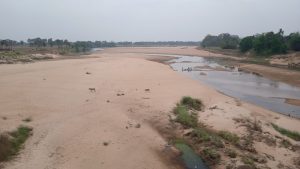Kendrapara chases a ‘pipe’ dream

Kendrapara: The Central government has identified Kendrapara district as Odisha’s only water-stressed district and included it in the Jal Shakti Abhiyan for groundwater recharge initiatives. However, locals allege that they have seen little improvement as the government’s mission to ensure a piped water supply to every household by 2024 has fallen flat in this coastal district. With mercury soaring, an exacerbating drinking water crisis gives burning evidence of the mission’s failure.
Moreover, seven rivers under the Mahanadi, Brahmani and Baitarani systems have dried up, leaving the district’s residents without access to potable water. To top it all off, over 10,000 tube wells are throwing saline water. The above factors are indicative of the severity of the drinking water crisis plaguing the residents of this coastal district.
Complaints of water shortage are rising during public grievance camps with people often resorting to agitations in various areas due to lack of piped water supply.
According to the Rural Water Supply and Sanitation (RWSS) department, Kendrapara district has 17,238 tube wells, 331 drinking water projects and 181 overhead tanks intended to supply drinking water to villagers. Yet, residents say they are not getting the intended benefits with most of the tube wells discharging saline water.
Social activists Pratap Padhi, Bibhuti Bhusan Rout, Pratap Ranjan Tripathy, Debashis Samal and Prakash Chandra Das pointed out that despite the presence of seven rivers, Kendrapara faces a serious drinking water crisis. Due to its coastal location, groundwater in the district has turned saline. Overhead tanks are often dry, and digging a single tube well now costs at least Rs3 lakh, which is a gamble as it might spew salty water in the end. Additionally, industries and agricultural activities under the Mahanadi, Brahmani and Baitarani river systems are drawing excessive amounts of water.
To make it worse, presence of barrages upstream reduces the water flow, further diminishing groundwater recharge potential. Reports from both state and Central Water Resource departments indicate that groundwater in areas like Garadpur block is no longer suitable for drinking.
Similarly, absence of canal in Aul, Mahakalapara, Rajnagar and Rajkanika blocks in the district makes groundwater recharge even more diffi cult. Proximity to the sea has also worsened the water salinity, especially in Mahakalapara block.
In 2019, Kendrapara was the only district in the state selected in the Jal Shakti Abhiyan to boost groundwater recharge. The campaign focused on installing shocking pipe fittings in tube wells, afforestation, rainwater harvesting, and the revival of water sources. However, due to administrative negligence, the campaign failed to achieve its objectives, and groundwater recharge could not be realised. Meanwhile, the district also fell short of its target to supply drinking water through pipelines to 2,91,160 families by March 2025. So far, only about 33,000 families have benefited from the initiative.
Several mega water supply projects have been launched across the district to improve piped water access, but many started without conducting proper land and environmental assessments. The drinking water project under construction at Manikunda under Marshaghai block has been halted following a National Green Tribunal (NGT) case.
Officials and political leaders have acknowledged that the lack of coordination between the administration and public representatives has contributed to these issues.
When contacted, Additional District Magistrate Nilu Mahapatra said a meeting on drinking water supply had been held recently. He added that various projects are underway to ensure piped drinking water reaches every household in rural areas soon.
PNN
News